Types of House Bugs (With Pictures) – Identification Guide
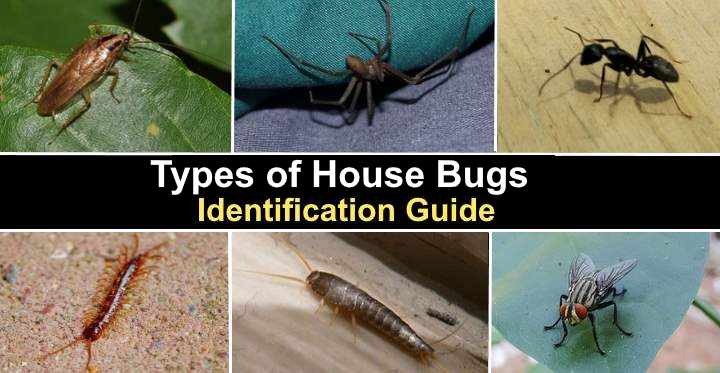
Nobody wants to discover any type of house bugs crawling or flying around their home. Many tiny kinds of bugs in the house, like pillbugs, fruit flies, and silverfish, are harmless and are more of a nuisance. But some small black or brown bugs like mosquitos, ticks, bed bugs, drain flies, or common houseflies can sting, bite, or spread diseases. Additionally, tiny house bugs like beetles, weevils, and ants can infest pantries and kitchen cabinets in the home.
Identifying types of house bugs is key to getting rid of them. Also, knowing about the habits, characteristics, and habitats of common critters that invade houses can help prevent them from becoming an annoyance.
This article is a guide to house bug identification. For example, suppose you have noticed tiny brown crawling creatures, flying brown or black insects, or bugs with long legs scurrying over floors in your home. In that case, you can learn about the creepy-crawly’s identifying features in this article.
How to Identify House Bugs
A house bug’s identifying features are the length and shape of the body, its number of legs, and whether it has wings.
For example, annoying insects like cockroaches, beetles, and earwigs are identified by their six legs, two antennae, and body shape. But minuscule bugs like ticks, fleas, pantry bugs, and bed bugs may be pear-shaped but hard to identify correctly because they are so tiny.
Also, where you find the bug in your house can be a clue to its identity. For example, black drain flies, fruit flies, and houseflies are attracted to rotten foodstuffs. But you might find tiny black beetles in stored grains and other dried food products. Bed bugs are usually found in dark crevices in bedrooms.
The Most Common Household Bugs
Ants are possibly the most common type of crawling household bug you’re likely to find in your home. But carpet beetles, spiders, and roaches are also common nuisance indoor pests. Fruit flies and drain flies are the most common flying bugs you’re likely to find in kitchens or bathrooms.
Types of House Bugs (With Pictures and Name) – Identification Guide
Suppose you spot crawly critters scampering over a countertop, furniture, or carpet. In that case, you probably want to know how to identify the bug. If you see a lot of roaches, mites, or bugs, you may be dealing with a severe bug infestation in your home. There are several steps you can take to identify the species.
Cockroaches (Blattodea)

Common roach (German roach/Blattella germanica) on the left and American roach (Periplaneta americana) on the right
Cockroaches are small household bugs with a distinctive reddish-brown, flattened oval body, six spiny legs, and a pair of characteristic feelers. The most common roach is the German cockroach (Blattella germanica) which is light brown with identifiable tan stripes on its back. The brown bugs measure up to 0.6” (15 mm) long.
Signs of a cockroach infestation include droppings that look like black pepper, a musty odor, and molted skins they leave behind. Getting rid of cockroaches is vital because they spread disease and contaminate food.
House Bug Identification
Cockroaches are easy to spot due to their flattened, oval brown bodies and long antennae.
Spiders (Araneae)

Left picture: brown recluse spider. Right picture: Black widow spider
Spiders are a common bug you will often find in your house. Spiders are identified by their bulbous two-segmented black or brown bodies, four pairs of legs, and six to eight eyes. In addition, spiders are classified by their shape, habitat, or characteristic webs. There are approximately 1,000 species of spiders in the US.
It’s essential to identify brown spiders because brown recluse spiders can give a nasty, venomous bite. Also, shiny black spiders with red violin markings are the dangerous black widow, injecting poison when they bite their prey.
Spiders are not classified as insects; instead, they are a type of arachnoid.
Related reading: How to identify 35 species of spiders.
House Bug Identification
Spiders are identified by their two body parts, eight legs, and a pair of jaws (chelicerae).
Centipedes
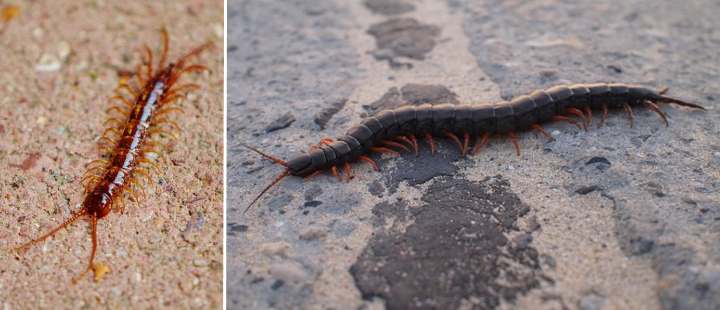
Centipedes are long and skinny creepy house bugs that are identified by numerous pairs of legs
Centipedes are common household bugs that are easy to identify due to their long, flattened, elongated bodies and numerous pairs of legs, two slender antennae, and two short tails. Centipedes are typically reddish-brown in color and can be tiny house bugs less than 1” (25 mm) in length or giant brown, slender bugs measuring over 12” (300 mm) in size.
Centipedes are a nuisance in homes with dampness issues. You might find the multi-legged flattened worm-like bugs under bathtubs, kitchen sinks, or in basements. Unfortunately, centipedes also have a venomous bite that can be exceedingly painful.
House Bug Identification
Centipedes are reddish-brown bugs that have lots of legs along their flattened bodies. Despite the name, not all centipedes have over a hundred legs.
Pillbugs (Armadillidiidae)
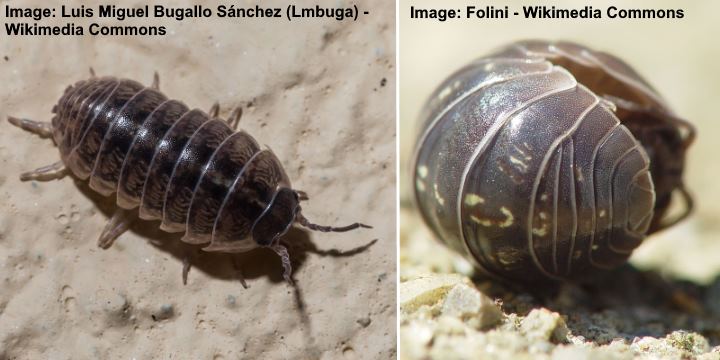
Pillbugs have dark hard segmented shell and can roll when they feel threatened
Pillbugs are small house bugs that have a distinctive segmented brown or gray body, making them look like a tiny armadillo. In addition, the small, brown hard-shelled critters have a unique habit of rolling into a ball for protection. These small beetle-like bugs have 14 legs and measure between 0.25” and 0.5” (6 – 12 mm) long.
Pillbugs usually live in large populations. Therefore, spotting one of these grayish rounded bugs in the house means there may be a large infestation. Moisture and dampness are the main things that attract pillbugs—also called sowbugs, slaters, roly-polies, and doodlebugs.
House Bug Identification
Pillbugs are tiny brown or black bugs identified by their prominent plates. Some of these grayish bugs may have yellow spotting.
Earwigs or Pincher Bugs (Dermaptera)
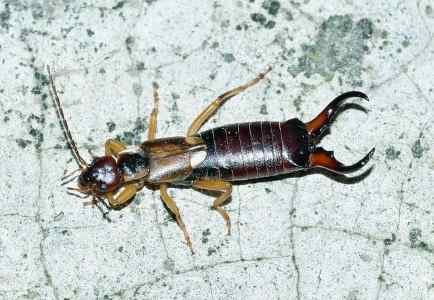
Earwigs (pincher bugs) are small skinny brown-black bugs that have pincers and antenna
Earwigs are long skinny brown bugs that can sometimes be black. Their identifying features include a slender dark brown, flattened body, pair of recognizable pinchers, and two antennae. Also called pincher bugs, the pesky insects with their brownish bodies measure 0.4” to 0.55” (10 – 14 mm) in length.
Earwigs are also a type of winged brown bug. However, they always scurry on the ground during nighttime and never fly.
House Bug Identification
Easy to identify, earwigs have two rounded pincers, a long elongated brown body, and two feelers.
Weevils (Curculionoidea)
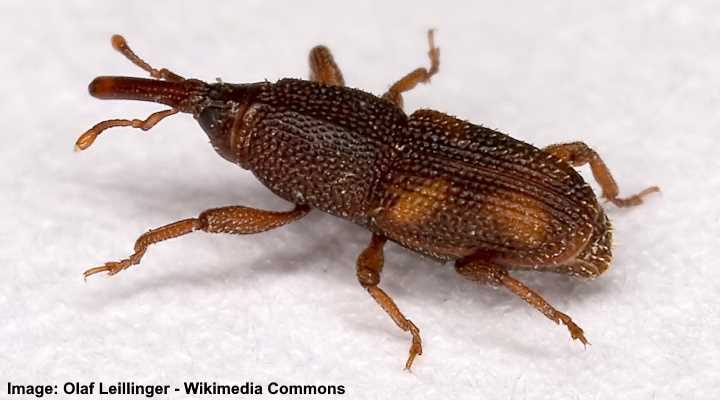
The rice weevil (Sitophilus oryzae) is a type of small brown beetle identified by its elongated snout
Weevils are tiny brownish beetles with a long snout that helps tell them apart from other beetle species. Other identifiable features of weevils are their elbowed antennae, and some have hairy tufts on their oval backs. Weevils don’t bite and are generally harmless. However, the brown nuisance bugs can infest pantry areas.
Weevils range in color depending on the species—from red to dull brown, beige, green, or red. Weevils measure less than 0.23” (6 mm) long.
House Bug Identification
Weevils are easily identified by their humped backs, oval bodies, and long rostrums (snouts).
Silverfish (Lepisma saccharinum)

Silverfish is a creepy bug commonly found in damp places at home
Silverfish is a long, flattened, wingless insect scurrying across bathroom and kitchen floors. The silvery bug gets its name from its shiny light gray and fish-like, slithering movements. Typically measuring 0.5” to 1” (12 – 25 mm) long, the tiny bug has long antennae, three bristles at its abdomen’s tip, and six legs.
Silverfish are a type of kitchen bug that usually inhabits dark, damp areas. Unfortunately, the silvery metallic insects are difficult to spot because they are nocturnal pests, only coming out at night.
House Bug Identification
Silverfish are tiny bugs identified by their silvery scales, oval-shaped, tapered bodies, and movements resembling a fish swimming in water.
Flying House Bugs (With Pictures and Name) – Identification Guide
Flying bugs in houses are irritating creatures that create infuriating buzzing noises. Not only are flying bugs annoying, but the pesky flies, gnats, and insects can also spread disease, bite, sting, or contaminate food. Let’s look at some common bugs you may find flying around your house.
Houseflies (Musca domestica)

Houseflies (Musca domestica) are common house bugs that can cause infestation in large quantities
The common housefly is an annoying dark gray or black house bug with a yellow or gray abdomen and four dark longitudinal stripes. An identifying feature of houseflies is their large reddish eyes. The disease-carrying flying bug also has a pair of translucent wings. The flying insects measure 0.2” to 0.27” (6 – 7 mm) long.
Houseflies are easy to differentiate from other flying bugs in the house. They have a characteristic erratic flying behavior, make irritating buzzing noises, and have excellent eyesight—which is why they are difficult to swat.
House Bug Identification
The common housefly has a blackish to gray body, gray and black striped thorax, and large reddish-brown compound eyes.
Drain Flies (Psychodidae)
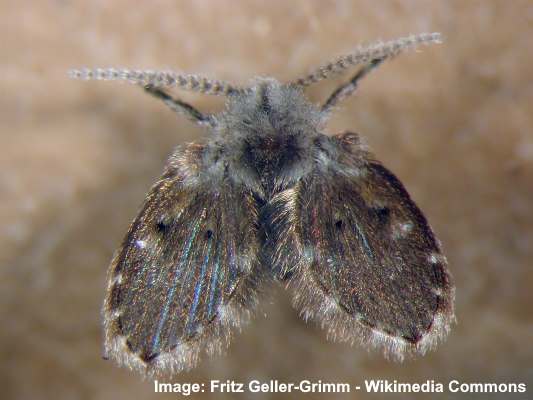
Drain flies are tiny flying house bugs with gray-brown furry look
A drain fly is a furry flying bug with a gray or brown-colored body and wings covered in long, thin hairs. A characteristic habit of drain flies is how they fold their wings over when at rest. The drain fly measures about 0.06” to 0.2” (1.5 – 5 mm) long.
As the name suggests, drain flies are often a nuisance near sinks where the flies, eggs, and larvae live in built-up slime in drains. The trash-loving fuzzy flying bugs are easy to mistake for fungus gnats or fruit flies.
House Bug Identification
The drain fly is a small gray moth-like fly often seen hovering around sinks and drains in your home.
Fruit Flies (Drosophila melanogaster)

Fruit flies are tiny brown house bugs that especially like sweet rotten fruit
A fruit fly is a common tiny yellowish-brown flying household bug with an oval body, red eyes, short legs, and little wings. The small bugs only measure around 0.1” (2.5 mm) long and tend to hover in place over rotten fruit, trash cans, and pet food. You will often notice the light brown flies in summer through fall in your kitchen.
The best way to eradicate fruit flies from your kitchen is to remove all food from countertops. Store fruit and vegetables in the refrigerator and keep a tight lid on the garbage can. Also, don’t leave pet food out for longer than necessary.
House Bug Identification
A fruit fly is a small oval, tan-colored winged bug attracted to fermenting or decaying food, liquids, and garbage.
Clothes Moth (Tineola bisselliella)
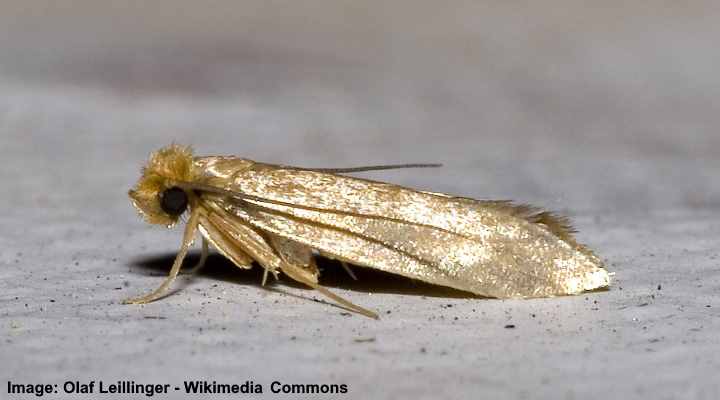
The clothes moth is a little house bug whose larvae cause damage to natural fabrics
Also called a webbing clothes moth, this common household pest is a golden yellow winged bug that has a yellowish or reddish fuzzy head, two large black eyes, and elongated wings with a slightly fuzzy coating. The yellowish moths measure 0.47” to 0.66” (12 – 17 mm) long and tend to inhabit dark areas.
The larvae of clothes moths can do plenty of damage in the home. The creamy-white worm-like maggots feed on clothes, carpets, rugs, upholstery, and other fabrics.
House Bug Identification
A clothes moth is easy to identify by its golden yellowish color and elongated wings with pointed ends.
Whiteflies (Aleyrodidae)

A close up picture of a whitefly. The tiny whitefly is a pest that can usually be found on the underside of the houseplant’s leaves
Whiteflies are common indoor flying bugs if you have houseplants. The plant-destroying, white-colored flies have a fuzzy appearance. They are identified by having four wings, a pair of short antennae, and red eyes. Whiteflies measure 0.08” (2 mm) swarm around infected houseplants.
Whiteflies bite into plant tissue to suck the juices from the leaves and stems. A large infestation of whiteflies can weaken a plant’s health, causing it to die eventually. Like other types of aphids, whiteflies also spread plant diseases.
House Bug Identification
Whiteflies are identified as tiny winged flying white bugs that infest houseplants.
Mosquitoes (Culicidae)

Mosquitoes are bloodsucking insects with one pair of wings, slender body and 3 pairs of long legs
Mosquitoes are blood-sucking, flying bugs that are common in homes. They have slender brown bodies, long legs, and tiny wings. The characteristic trait of mosquitoes is how they pierce the skin to enjoy a blood meal. The flying insects come out at dusk and can be a pest to people, not to mention spreading diseases like malaria, dengue fever, and the Zika virus.
Mosquitoes are tiny, measuring 0.1” to 0.7” (2 to 19 mm) long. They are also tricky to swat because they react swiftly to changes in air pressure.
Related reading: Plants that repel mosquitoes.
House Bug Identification
Mosquitoes are tiny brown flies with six legs, two wings, and a long slender mouthpart (proboscis) the female uses to pierce human or animal skin.
Small House Bugs (With Pictures and Name) – Identification Guide
Small house bugs are annoying pests, many of which bite humans, spread disease, or contaminate foodstuffs. It’s vital to identify the types of bugs you find in your house to know the best ways to get rid of them.
Fleas (Siphonaptera)
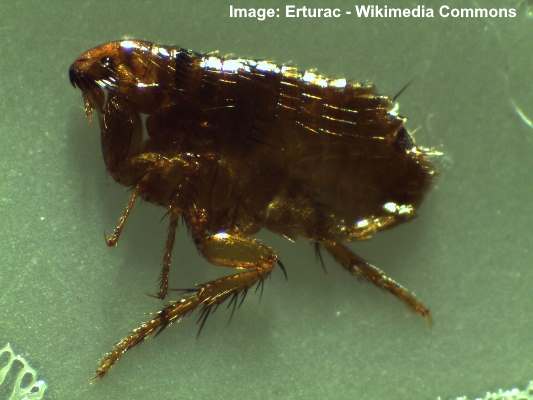
A close up picture of a flea
Fleas are microscopic brownish bugs that can jump from host to host, spreading disease and infections. Due to their tiny size, fleas are difficult to spot and catch. These household bugs have oval body and long legs, and the jumping bug is the size of a pinhead, between 0.04” and 0.13” (0.1 – 0.3 mm).
House Bug Identification
Fleas are minuscule bugs that look like tiny black spots that jump around quickly.
Bed Bugs (Cimex)

The tiny brown bed bugs have a flat body and can quickly infest the house
Bed bugs are disgusting flat reddish-brown insects about the size of an apple seed. These tiny flat, parasitic bugs are hard to find at homes because they live in dark crevices of bed frames, box springs, the seams of mattresses, and behind baseboards. The tiny brown bugs measure 0.2” to 0.27” (5 – 7 mm) long.
House Bug Identification
The easiest way to identify bed bugs is to look for signs of their activity. This includes itchy skin spots, rusty or reddish stains on sheets or mattresses, and musty-smelling bed bug feces that resemble tiny black dots.
Varied Carpet Beetle (Anthrenus verbasci)
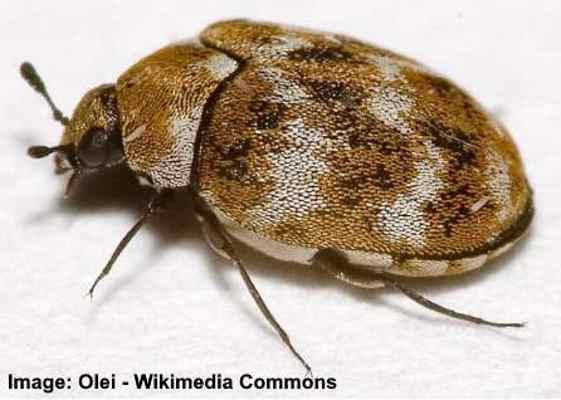
The tiny varied carpet beetle feeds on natural fibers and has brown, white and yellow-beige body
The varied carpet beetle is a tiny house bug with brown, yellowish, and white patches on its oval body, six legs, and short antennae. The flying bugs also have wings, and the adults tend to be harmless. The flattened, rounded creatures measure between 0.7” and 0.14” (1.7 – 3.5 mm).
Another type of carpet beetle is the black carpet beetle (Attagenus unicolor). The adult beetles don’t do any damage. Instead, the pesky white larvae can eat holes in soft upholstery, carpets, and fabric.
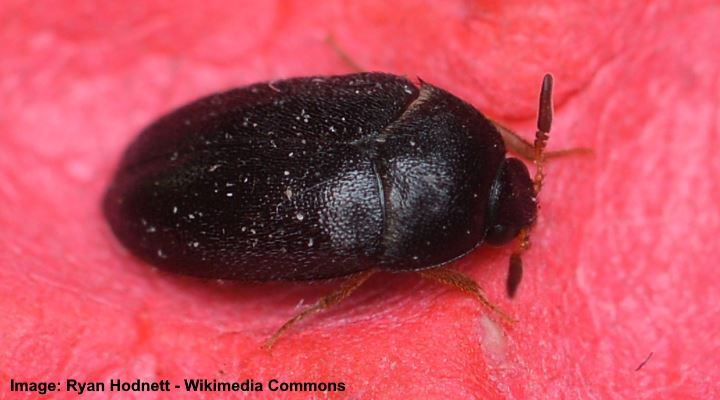
The black carpet beetle is a tiny bug that infests carpets and fabrics in the house
House Bug Identification
Carpet beetles are identified as tiny house bugs with mottled yellowish and white patches on their wing coverings.
Ants (Formicidae)
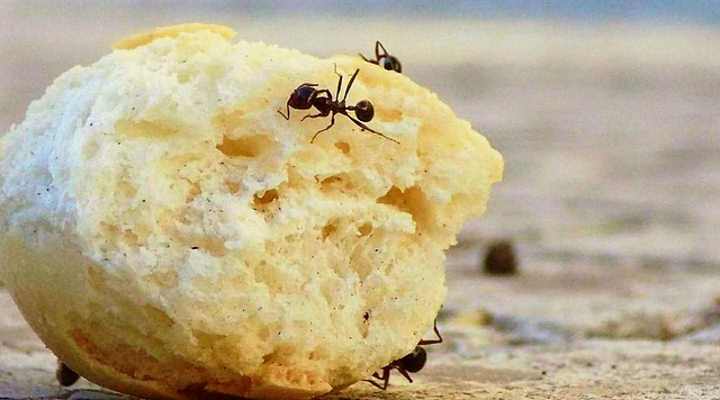
Pantry ants are attracted to many types of food leftovers in the kitchen
Ants are tiny insects commonly found in homes. Ants are typically easy to identify with their three slender body parts, a thin waist, two antennae, and bulbous abdomen. Ants are usually black, but there are also species of red, dark brown, and light brown ants. On average, ants measure between 0.03” and 2” (0.75 to 20 mm).
Some ants, like fire ants, bite and can cause a severe stinging sensation. Other types of black ants, like carpenter ants, damage wooden structures by burying into dead wood.
The six-legged red or brown pests tend to invade homes when cold and wet outside.
Further reading: Types of Ants – Identification Guide.
House Bug Identification
Ants are an easily identifiable bug in the house due to their slender bodies, rounded abdomens, and six legs.
Ticks (Ixodida)

A close up picture of a tick (left) and a tick on human skin (right)
Ticks are tiny bugs that get into the house on animals, human skin, or clothing. These minuscule pear-shaped oval arachnids have eight legs, a reddish-brown color, and measure 0.1” (3 mm) long. The pesky, disease-carrying bugs bury into the skin to feed on blood.
You might only notice a tick when it’s half-buried into the skin and looks rounded, red, and gorged. However, it’s vital to identify ticks after you or your pet have been outdoors to reduce the risk of disease.
House Bug Identification
Ticks are dark brown to reddish-brown with a tear-shaped body about the size of a sesame seed.
Termites (Isoptera)

Termites (Isoptera) are brown bugs that can infest homes and cause extensive damage to wood
Termites are destructive creamy-colored or brown pests about the size of tiny ants. The small pale-colored bug has an elongated oval to tube-shaped body, six legs, and two straight antennae. Termites typically measure between 0.15” and 0.6” (4 – 15 mm) long. Usually, termite damage goes unnoticed until there is extensive structural damage.
It’s crucial to identify the differences between termites and ants. Unlike ants, termites don’t have a thin waist and three distinct body parts. Additionally, they have straight beaded antennae, not crooked antennae like ants.
House Bug Identification
Termites are identified by their pale-colored cylindrical bodies, bulbous heads, and straight antennae.
Pantry Bugs
There are several species of pantry bugs that are typically tiny house beetles or weevils. The pesky bugs measure around 0.78” to 0.18” (2 – 4.7 mm) long. The small kitchen bugs have oval bodies, six legs, and stumpy antennae. They are also usually a reddish-brown color.
Types of pantry bugs include:
- Flour beetles
- Sawtoothed grain beetles
- Rice weevils
- Drugstore beetles
- Granary weevils
- Flour weevils
Find out how to identify many other types of pantry bugs.
Related articles:
